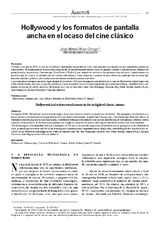Hollywood y los formatos de pantalla ancha en el ocaso del cine clásico
Hollywood and widescreen formats in the twilight of classic cinema
Autor
Neves Carrega, Jorge
Editor
Asociación de Estudios de Ciencias Sociales y HumanidadesFecha
2021Materia
WidescreenCinemascope
Cine clásico
Estudios de Hollywood
Zanuck, Darryl F., 1902-1979
Classical Hollywood Cinema
Studio system
METS:
Mostrar el registro METSPREMIS:
Mostrar el registro PREMISMetadatos
Mostrar el registro completo del ítemResumen
Durante la década de 1950, el cine de Hollywood experimentó una profunda crisis, directamente relacionada con una importante pérdida de espectadores. El surgimiento de la televisión como medio de entretenimiento masivo llevó los grandes estudios a apostar por los formatos de pantalla ancha, en particular Cinemascope, VistaVision y Todd AO, que, además de introducir dimensiones espectaculares, contribuyeron a la masificación del color y la introducción del sonido estereofónico como elementos centrales de una estética de participación sensorial que buscaba cautivar al público, ofreciéndole una alternativa al entretenimiento televisivo. La revolución tecnológica que tuvo lugar durante la década de 1950 tuvo un impacto considerable en el cine de Hollywood, dando lugar a un estilo exhibicionista, en el que la espectacularidad y el acto de mostrar era a veces más importante que contar una historia, contribuyendo a este modo a la erosión del estilo clásico de Hollywood en el cine de directores como Otto Preminger, Nicholas Ray, Frank Tashlin, Samuel Fuller, Jean Negulesco, Richard Fleischer y Vincente Minnelli. During the 1950s, Hollywood cinema went through a deep crisis, directly related to a major loss of viewers. The emergence of television as a means of mass entertainment led major studios to bet on widescreen formats, in particular Cinemascope, VistaVision and Todd AO, which, in addition to introducing spectacular dimensions, contributed to the massification of color and the introduction of stereophonic sound as central elements of an aesthetic of sensorial participation that sought to captivate the public, offering an alternative to television entertainment. The technological revolution that took place during the 1950s had a considerable impact on Hollywood cinema, giving rise to an exhibitionist style, in which spectacularity and the act of showing was sometimes more important than telling a story, contributing for the erosion of the socalled classic Hollywood paradigm in the works of film directors like Otto Preminger, Nicholas Ray, Frank Tashlin, Samuel Fuller, Richard Fleischer, Jean Negulesco and Vincente Minnelli.

